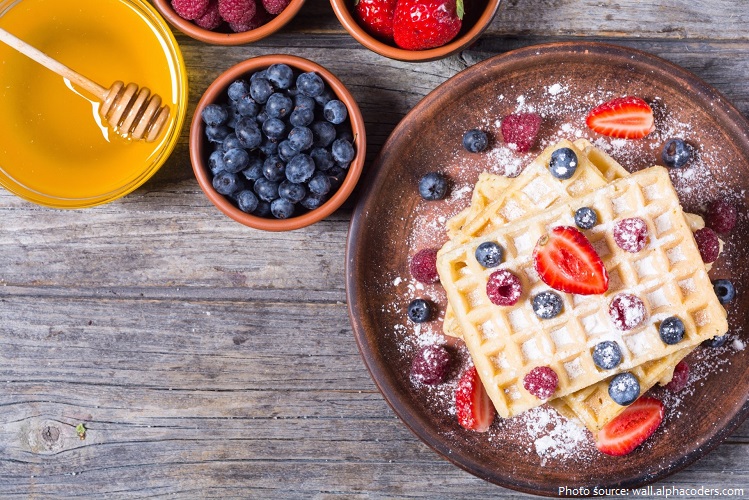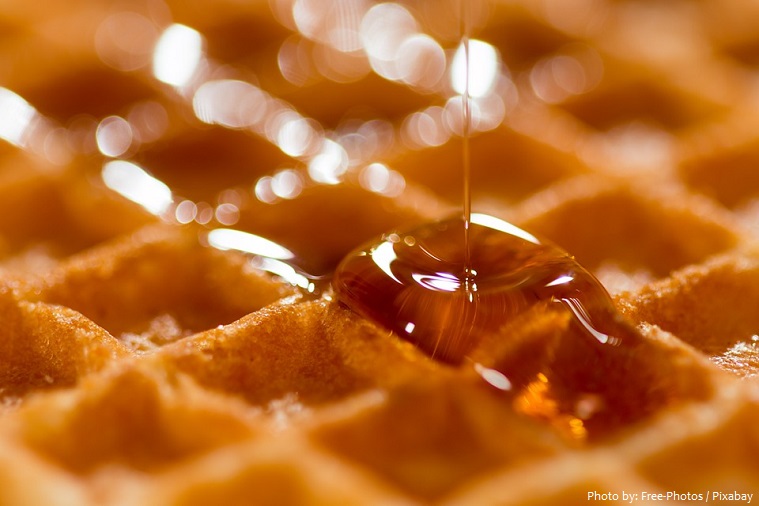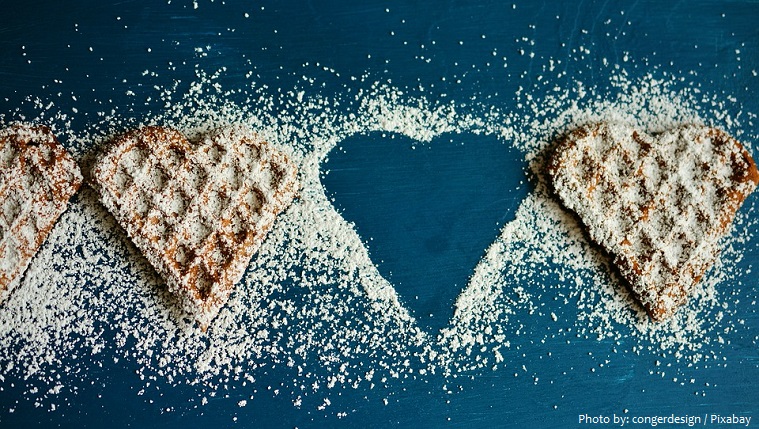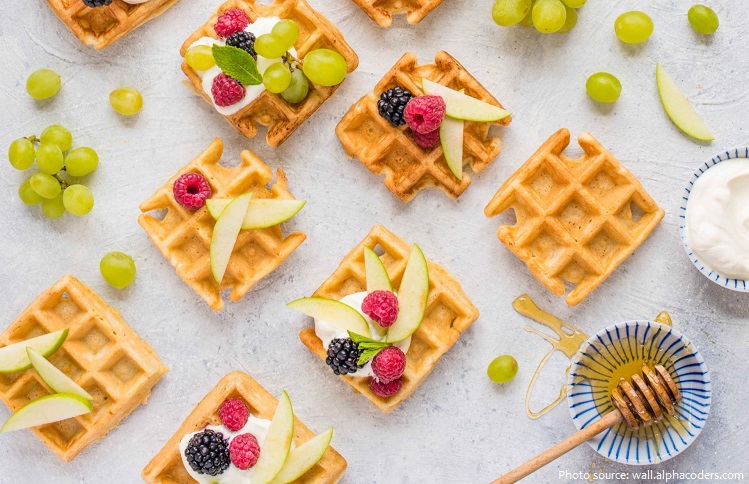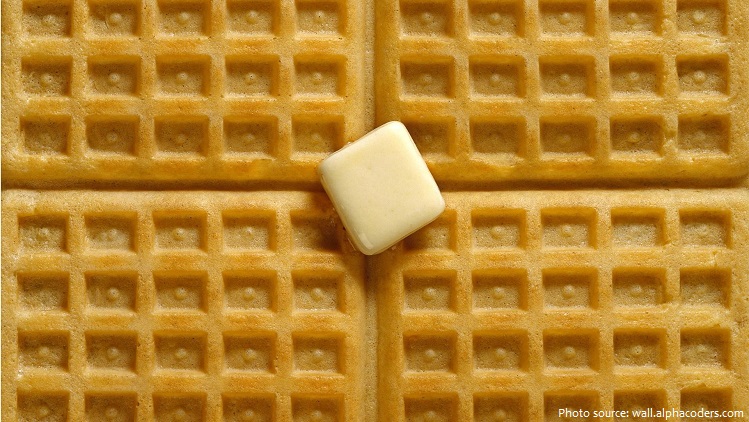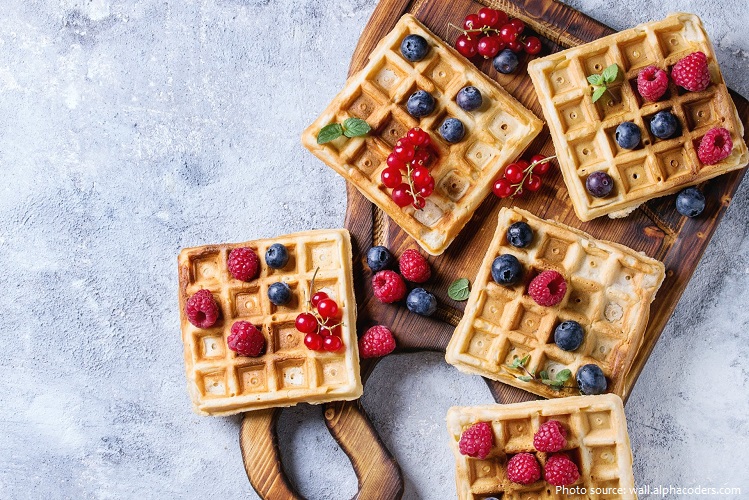A waffle is a grid-patterned pancake-like food.
It is made from a batter that consists of flour, water, baking powder, oil, and eggs.
A waffle is baked in a waffle iron, a hinged metal griddle with a honeycombed or fancifully engraved surface.
There are many variations based on the type of waffle iron and recipe used.
Waffles are cooked until they become golden-brown in color, with a crispy outer texture and a soft interior.
They are served as a breakfast or as a dessert, and they are usually served with sweet sauces or toppings such as chocolate syrup, bananas, strawberries, or whipped cream.
Waffles are eaten throughout the world, particularly in Belgium, which has over a dozen regional varieties.
In ancient times the Greeks cooked flat cakes, called obelios, between hot metal plates. As they were spread throughout medieval Europe, the cake mix, a mixture of flour, water or milk, and often eggs, became known as wafers and were also cooked over an open fire between iron plates with long handles.
Waffles are preceded, in the early Middle Ages, around the period of the 9th–10th centuries, with the emergence of oublies. They typically depicted imagery of Jesus and his crucifixion, trivial Biblical scenes or simple, emblematic designs.
Oublies were sold as street food at fairs and religious festivals.
The oublie becomes the waffle in the 1400s, when a craftsman has the idea of forging some cooking plates or “irons” that reproduce the characteristic pattern of honeycombs.
The word “waffle” first appears in the English language in 1725: “Waffles. Take flower, cream…” It is directly derived from the Dutch wafel, which itself derives from the Middle Dutch wafele.
In 1789, Thomas Jefferson returns to the US from France with many French recipes. In addition, he came back with a long-handled waffle iron that encloses the batter and gives the waffle crispness and shape.
In 1869, Cornelius Swarthout of Troy, New York, a Dutch-American, receives a patent for the first waffle iron in the US, on August 24th. Described as a “device to bake waffles,” one heats up the waffle iron over a coal stove, pour batter on the griddle, close the cover and after a few minutes, flip the griddle and cook the other side of the waffle. It becomes very popular. The anniversary of the patent is now celebrated as National Waffle Day.
In 1911, Thomas J. Stackbeck creates the first commercial electric waffle iron for General Electric, by the 1930’s it becomes a staple in the American kitchen.
Eggo waffles were invented in San Jose, California, by Frank Dorsa, who developed a process by which waffles could be cooked, frozen, and packaged for consumers. In 1953, Dorsa, along with younger brothers Anthony and Sam, introduced Eggo frozen waffles to supermarkets throughout the United States. Frozen waffles do not require a waffle iron to prepare.
Originally showcased in 1958 at Expo 58 in Brussels, Belgian waffles were introduced to North America by a Belgian named Walter Cleyman at the Century 21 Exposition in Seattle in 1962, and served with whipped cream and strawberries. The waffles were further popularized in the United States during the 1964 New York World’s Fair at Flushing Meadows Park in Queens, New York City.
The largest waffle weighs 50 kg (110 lb 3.68 oz) and was created by Stichting Gouda Oogst (Netherlands) in Nieuwe Markt, Gouda, Netherlands, on 29 June 2013. The waffle had a diameter of 2.47 m (8 ft 1.24 in).
The tallest stack of waffles is 67 cm (26.38 in), and was achieved by Spencer McCullough and Cory Trimm (both USA) in Denver, Colorado, USA, on 26 May 2018. Spencer and Cory decided to attempt this record as a fun way to meet their neighbors and other residents of Denver.
Pancakes outnumber the waffle five to one.
Waffle is also a slang term meaning “to keep changing one’s mind.”. For example, if a reporter is asking a politician a question, and the politician does not give a clear answer, the reporter might say that the politician was “waffling.” It can also mean to keep repeating the same information in a different way or make no useful points.
